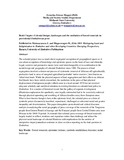Please use this identifier to cite or link to this item:
https://cris.library.msu.ac.zw//handle/11408/1882Full metadata record
| DC Field | Value | Language |
|---|---|---|
| dc.contributor.author | Mugari, Zvenyika E. | - |
| dc.date.accessioned | 2017-03-03T08:57:22Z | - |
| dc.date.available | 2017-03-03T08:57:22Z | - |
| dc.date.issued | 2015 | - |
| dc.identifier.uri | http://hdl.handle.net/11408/1882 | - |
| dc.description.abstract | The colonial project was as much about segregated occupation of geographical spaces as it was about occupation of knowledge and epistemic spaces on the basis of race and ethnicity. Legal, coercive and persuasive means were used interchangeably or in combination in the racial design and geography of colonial Zimbabwe since 1890. The process of land segregation involved a drawn-out process of systematic removal of Africans off agriculturally productive land to areas of marginal agricultural potential ‘native reserves’, later known as ‘tribal trust lands. While the physical aspects of land segregation and their effects on African livelihoods have been widely researched, the mediation in the press of that physical displacement of indigenous peoples which came to a head around 1970 has not received adequate scholarly and analytical attention in existing literature on colonial land policy in Zimbabwe. It is a matter of historical record that the policy of separate development (Rhodesian euphemism for apartheid), once legally entrenched had to be coercively enforced through physical uprooting and resettling of African families away from European areas. What is least known though is how at the epistemic level, the colonial press as a form of symbolic power discursively inscribed, reproduced, challenged or subverted racial and gender inequality and discrimination. This paper triangulates postcolonial and critical discourse analysis in analysing the racial geography of press coverage of the removals of the Tangwena people from Gairezi Ranch in Inyanga and the Hunyani people from Central Estates area near Mvuma in the 1969-70 period. It contends that colonial press coverage of forced removals largely tended to reflect, reinforce and reproduce rather than challenge and refract the physical racial landscape of colonial Rhodesia with implications for the archive of interpretive tropoi journalism continues to draw on when reporting on the land question in Zimbabwe. | en_US |
| dc.language.iso | en | en_US |
| dc.publisher | University of Zimbabwe Publications | en_US |
| dc.relation.ispartofseries | Dialoguing Land and Indigenisation in Zimbabwe and other Developing Countries: Emerging Perspectives, edited by Makwavarara Z. and Magosvongwe R.; | - |
| dc.subject | Forced removals; epistemic violence, symbolic annihilation; discourse; racial landscape | en_US |
| dc.title | Colonial designs, landscapes and the mediation of forced removals in postcolonial Zimbabwe | en_US |
| dc.type | Book chapter | en_US |
| item.fulltext | With Fulltext | - |
| item.openairetype | Book chapter | - |
| item.languageiso639-1 | en | - |
| item.cerifentitytype | Publications | - |
| item.grantfulltext | open | - |
| item.openairecristype | http://purl.org/coar/resource_type/c_18cf | - |
| Appears in Collections: | Book Chapters | |
Files in This Item:
| File | Description | Size | Format | |
|---|---|---|---|---|
| Colonial Designs.pdf | Abstract | 125.46 kB | Adobe PDF |  View/Open |
Items in MSUIR are protected by copyright, with all rights reserved, unless otherwise indicated.


